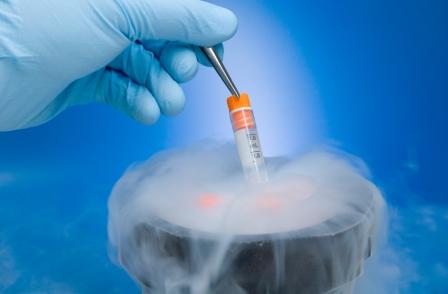The Importance of Storing Stem Cells
At VetStem, we have the potential to store stem cells from each patient whose fat we process. It is our general protocol to store a small number of stem cells from each fat sample for potential future use. Known as the Retention Sample, this small number of cells affords us the ability to provide stem cell treatments for the life of the patient from whom the cells came. More on that later.
Storage of Stem Cell Doses for Future Use
In addition to the Retention Sample, VetStem has the ability to store any unused stem cell doses from the initial stem cell process. How does this work exactly? Let’s say your dog has bilateral hip dysplasia and osteoarthritis and your veterinarian plans to give your dog an injection of stem cells directly into each hip as well as an intravenous injection. Three injections equals three doses. But suppose the fat sample from your dog had enough cells to provide six doses. Well, those extra three doses would then be cryopreserved for potential future use. And then down the line, if your dog started showing signs of discomfort, your veterinarian could request those three doses for a second stem cell treatment.
The Retention Sample Can Be Used to Provide More Doses
In keeping with this same scenario, your dog has now had two rounds of treatment, three injections each time. Therefore, all six doses from the initial fat processing have now been used. That is where the Retention Sample comes in. Our standard protocol is to store a small number of cells from every fat sample that we process. For a fee, the Retention Sample can be put into culture to grow more stem cells. The cultured stem cells will be genetically identical to your dog’s original stem cells. And once the culture process is complete (it takes approximately 3-4 weeks), your dog will have usable stem cell doses again.
Cryopreservation of Stem Cells

Cryopreservation of stem cells allows the cells to maintain their functional properties. When stored at very low temperatures, the cells can be stored for long periods. Normal biological processes are slowed allowing the regenerative properties of stem cells to remain intact. Cryopreserved cells will last the lifetime of your pet.
With the ability to culture and store extra stem cell doses, your pet should only have to undergo one fat collection procedure. Having extra doses available for use also eliminates waiting time. We ship stem cell doses out Monday through Friday and can work with short notice in most cases. This is especially beneficial for some of the animals who are battling life threatening conditions such as kidney disease.
If your pet has cells stored at VetStem and you have questions regarding those stored cells, do not hesitate to contact us! We can be reached by phone at 858-748-2004, email, or through our contact page. Alternatively, if you would like to receive a list of VetStem providers in your area, contact us here.
